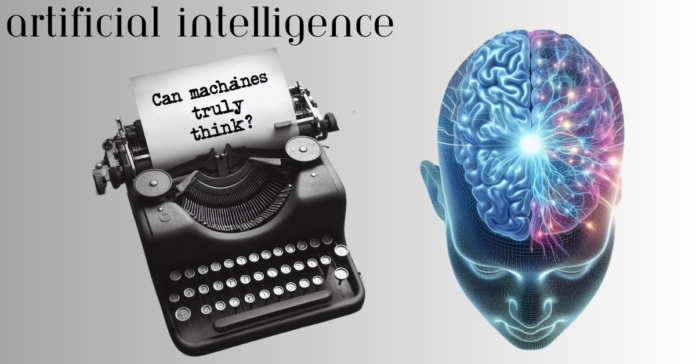The human fascination with intelligent machines stretches back centuries, from mythical automatons to science fiction’s visions of robots surpassing human intelligence. Today, with the rise of artificial intelligence (AI), this age-old question has taken on a new urgency. AI has achieved remarkable feats, from defeating chess grandmasters to composing music and even writing convincing news articles. But can these accomplishments be equated with true thought? Can a machine ever truly understand the world and itself the way a human can?
Defining Intelligence: The Turing Test and the Chinese Room Argument
At the heart of this debate lies the very definition of intelligence. What constitutes the ability to think? Is it simply the ability to process information and solve problems, or does it require something more—consciousness, self-awareness, or the ability to feel emotions?
One of the most influential figures in the early days of AI was Alan Turing, a pioneer of computer science and artificial intelligence. In his seminal 1950 paper, “Computing Machinery and Intelligence,” Turing proposed the Turing Test, a thought experiment designed to assess a machine’s ability to exhibit intelligent behavior equivalent to, or indistinguishable from, that of a human. The test involves a human interrogator conversing with a hidden human and a machine through a teletype terminal. If the interrogator cannot reliably distinguish the machine from a human based on the conversation, then the machine is considered intelligent. The Turing Test has become a benchmark for AI research, driving development towards machines that can understand and respond to natural language in a human-like way.
However, the Turing Test has also faced criticism. John Searle, a philosopher, challenged the test’s validity with his “Chinese Room” argument. He imagined a person who doesn’t understand Chinese following a set of rules to manipulate Chinese symbols according to a pre-defined codebook. This person could, in theory, converse in Chinese and even pass the Turing Test, despite having no actual understanding of the language. Similarly, Searle argues, AI systems might manipulate data and respond to prompts in a way that simulates human conversation without truly comprehending the meaning behind it. The Chinese Room thought experiment highlights the limitations of the Turing Test and emphasizes the importance of understanding, not just imitation, in true intelligence.
Learning and Adapting: Pattern Recognition vs. True Understanding
The debate goes beyond philosophical thought experiments. The ability of AI to learn and adapt is another key point of contention. Machine learning algorithms can analyze vast amounts of data and improve their performance over time. They can identify patterns, make predictions, and even generate creative content. However, critics argue that this is a form of sophisticated pattern recognition, not true learning, that requires understanding the underlying principles and concepts. Humans can learn from a single example and apply that knowledge to new situations. Can AI achieve this level of flexible and generalizable learning, or is it limited to tasks for which it has been specifically programmed?
Proponents of AI counter that human thought itself might be a complex form of pattern recognition. We learn through experience, which involves identifying patterns in the world around us. Our brains process information and make connections, allowing us to solve problems, adapt to new situations, and even exhibit creativity. Perhaps then, true intelligence lies not in the specific mechanisms but in the ability to achieve complex tasks and goals, regardless of how those tasks are accomplished.
The Blurring Lines: Deep Learning and the Path to Artificial General Intelligence
As AI continues to evolve, the line between sophisticated algorithms and genuine thought may become increasingly blurred. Deep learning algorithms with artificial neural networks are showing remarkable abilities to learn and adapt, even surpassing human performance in some narrow tasks. Can these advancements pave the way for the emergence of artificial general intelligence (AGI), a machine that can think and learn in a way that is indistinguishable from a human?
The Future of Intelligence: Collaboration, Ethics, and Redefining Intelligence
The question of whether machines can think is not just an academic one. It has significant implications for the future. As AI becomes more integrated into our lives, from self-driving cars to personalized healthcare, we need to understand its capabilities and limitations. Can AI be a true collaborator and partner, or is it simply a powerful tool that requires careful human oversight? Can AI be trusted to make critical decisions, or will human judgment always be necessary?
The debate on AI and thinking has far-reaching ethical considerations as well. If machines can achieve true intelligence, what rights and responsibilities should they have? How can we ensure that AI development aligns with human values and serves the greater good? These are complex questions that require ongoing discussion and collaboration between scientists, ethicists, policymakers, and the public.
The quest for a mind in the machine is likely to continue for many years to come. As AI research progresses, we may need to revisit and refine our very definition of intelligence. Perhaps the true answer lies not in a binary “yes” or “no.”
Conclusion
The argument over whether machines are capable of genuine thinking is intricate. Even though AI has accomplished remarkable feats, it is still difficult to define intelligence. The complexity is demonstrated by the Turing Test and the Chinese Room Argument. As AI advances, concerns about real learning and flexibility emerge, causing a mix between algorithms and authentic cognition. These conversations carry important societal consequences, such as ethical debates regarding the rights and duties of AI. Continual communication among various fields is crucial as we navigate the changing terrain of AI. In the end, our concept of intelligence could change as we delve into the real essence of thought.


